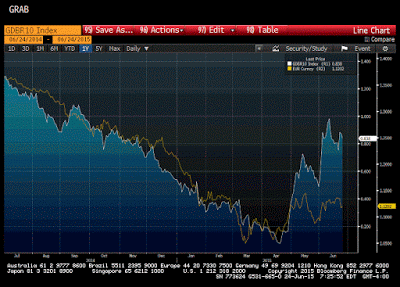
Previously there was a good fit between the direction of German bund yields and the euro. This Great Graphic from Bloomberg illustrates this. However, recently the relationship appears to be loosening. Consider that over the past week, the 10-year bund yield is up 3 bp and that is with today’s 3 bp decline. The euro has fallen 1.1% over the same period.
The correlations on direction suggest there was shock and the two become more linked, but it has lessened now. Specifically, over the past 100 sessions, the two moved in the same direction 60% of the time. Over the last 60 sessions, the two moved in the same direction about 86% of the time. In the past 30 sessions, the correlation moved back to 67%.
There are several possible explanations. First, if the tighter linkage was function of position and hedge adjustments, it perhaps has run its course as German yields stabilize. Second, the rise in US Treasuries and the generally stronger US economic data could be a mitigating factor. Third, Greek developments and the deadlines, and rumors and the like, have injected more noise into the market that is obscuring signals.
Market positioning has taken on a life of its own. As we noted, there was a large jump in gross long euro positions in the futures market last week (50%+). After the euro bottomed in mid-March, the main position adjusting was the reduction of gross short positions in the futures market. Only in recent weeks have new longs been established. Last week’s jump was the largest in percentage terms in a couple of years.
In the options market, it appeared that participants were buying downside protection.The discount for euro calls over euro puts reached the largest level in three years at the end of last week. This week it (the 3-month 25 delta risk reversal) jumped back and is now near the 100-day moving average.Meanwhile 3-month implied volatility has dipped below 11% for the first time this month.;

